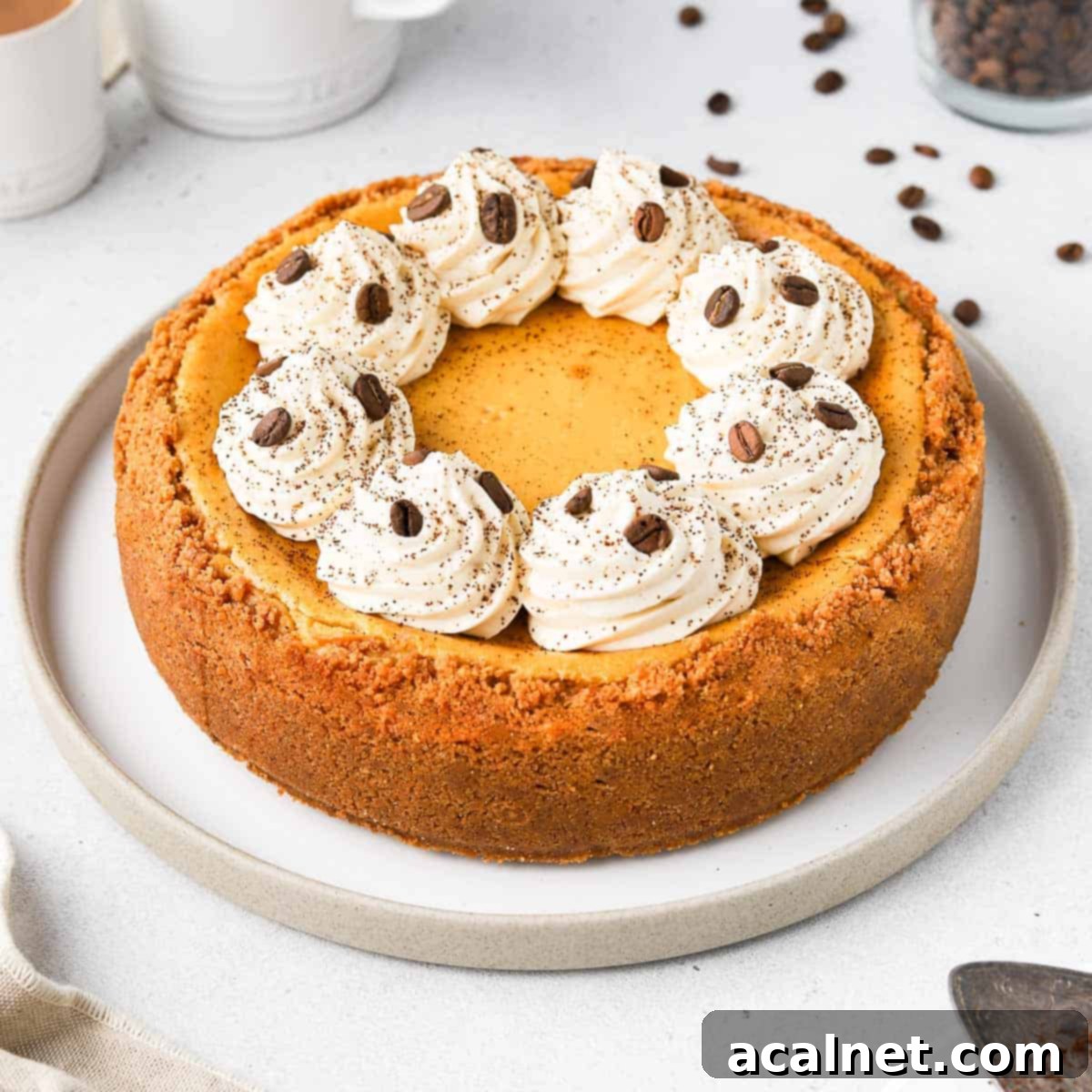Decadent Baked Coffee Cheesecake with Espresso Whipped Cream (No Water Bath!)
Prepare to tantalize your taste buds with this exquisite Baked Coffee Cheesecake, crowned with a luscious Coffee Whipped Cream. This dessert is a dream come true for any coffee aficionado, combining the rich, aromatic flavors of espresso with a wonderfully creamy, smooth, and perfectly balanced cheesecake texture. Forget complicated water baths – our recipe ensures a flawless, crack-free baked cheesecake every time, making it as enjoyable to make as it is to eat!
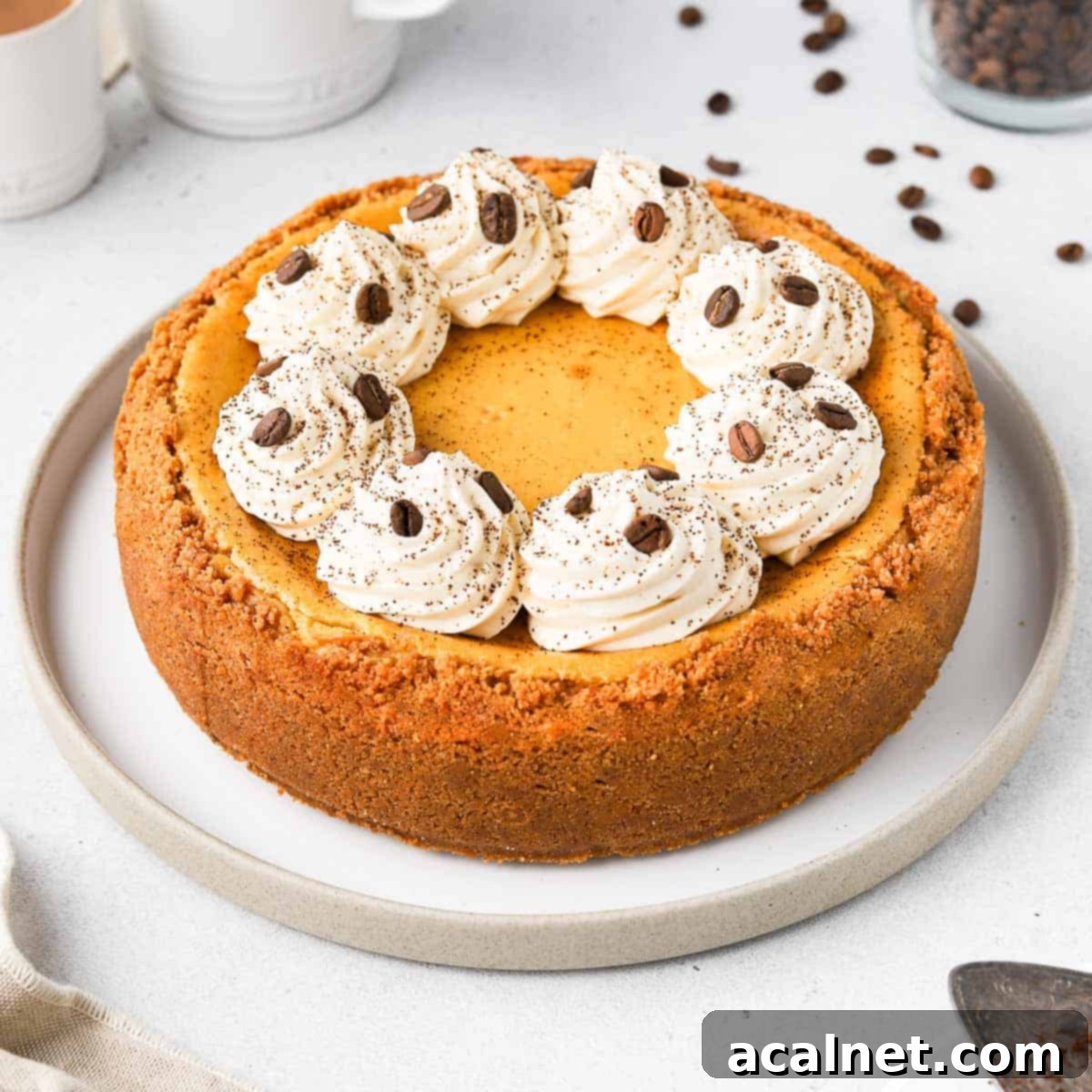
[feast_advanced_jump_to]
Why This Baked Coffee Cheesecake is a Must-Try
If you’re seeking a show-stopping, intensely flavorful dessert that’s both elegant and incredibly satisfying, this Baked Coffee Cheesecake recipe is precisely what you need. It’s the perfect indulgence for special occasions, dinner parties, or simply to treat yourself to an extraordinary coffee-infused delight. This recipe thoughtfully layers three distinct components: a perfectly crumbly cookie crust, a rich and smooth espresso cheesecake filling, and a light-as-air coffee whipped cream topping that ties all the flavors together.
Unlike many baked cheesecakes that can feel heavy, this recipe delivers a surprisingly light yet undeniably creamy texture. The coffee flavor is prominent and authentic, derived from real espresso, but it’s carefully balanced to enhance, rather than overwhelm, the delicate tang of the cream cheese. The result is a harmonious blend that leaves a lasting impression. Furthermore, this cheesecake is a fantastic make-ahead dessert, gaining even more incredible creaminess after a night in the fridge, making your hosting duties wonderfully stress-free.
One of the biggest advantages of this Espresso Cheesecake is that it’s made without a water bath. Many bakers dread the thought of using a water bath, but our proven techniques mean you can achieve a beautifully baked cheesecake with a smooth, unblemished surface – absolutely no cracks! Just follow our straightforward tips, and you’ll be rewarded with a professional-looking and tasting dessert that will impress everyone.
Discover More Decadent Cheesecake Recipes:
- Lemon Ricotta Cheesecake: A lighter, tangy option for citrus lovers.
- Mini Lemon Cheesecakes: Perfect individual portions bursting with lemon zest.
- Biscoff Cheesecake: Indulge in the spiced cookie butter goodness.
- Mini Blueberry Cheesecakes: Sweet berries meet creamy cheesecake in delightful small bites.
- Apple Crumble Cheesecake: A comforting fusion of two classic desserts.
- Mini Strawberry Cheesecakes: Fresh strawberries make these mini treats irresistible.
- Passion Fruit Cheesecake: For an exotic, tangy twist that brightens any table.
- No Bake Biscoff Cheesecake: All the flavor of Biscoff without turning on the oven.
- Chocolate Orange Cheesecake: A rich, zesty combination that’s truly luxurious.
Essential Ingredients for Your Coffee Cheesecake
Crafting this exquisite coffee cheesecake requires a careful selection of ingredients, divided into three main components: the irresistible cookie crust, the silky-smooth espresso cheesecake filling, and the optional (but highly recommended!) coffee-infused whipped cream topping. Each ingredient plays a crucial role in achieving the perfect flavor and texture.
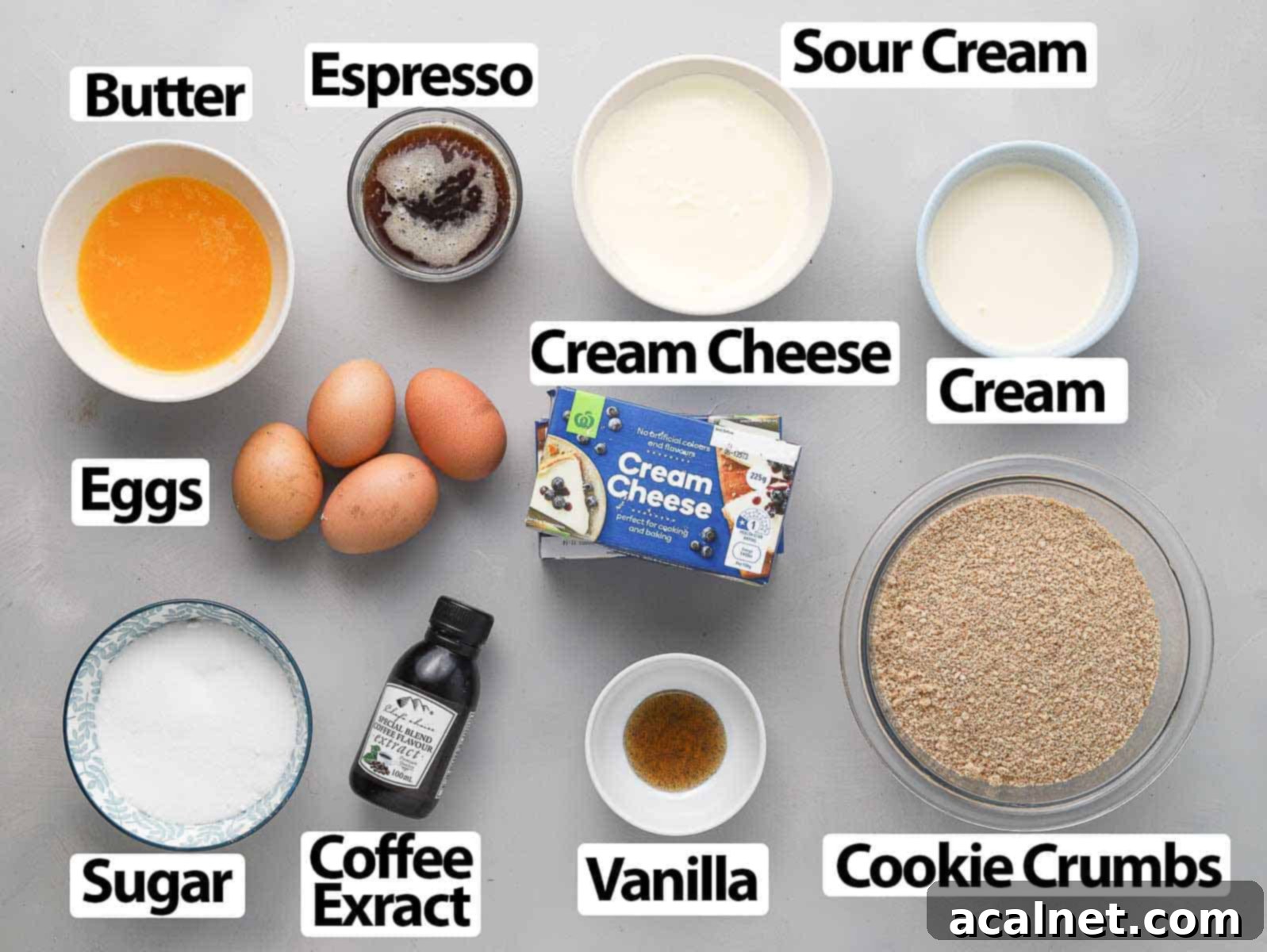
For the Cookie Crust:
- Cookies: We recommend using crushed Digestive Biscuits for their subtly sweet flavor and perfect texture. However, feel free to get creative! Graham crackers, Oreos (for a chocolatey twist), or Biscoff cookies are all excellent alternatives. If you choose an unsweetened cookie like graham crackers, you might want to add 1-2 tablespoons of granulated sugar to your crumbs for a balanced sweetness.
- Butter: Melted Unsalted Butter is essential for binding the cookie crumbs together to form a sturdy and delicious crust. Using unsalted butter allows you to control the overall saltiness of the dessert.
For the Espresso Cheesecake Filling:
- Cream Cheese: This is the star of any cheesecake! Always opt for full-fat cream cheese (block style, not whipped or spreadable) for the best richness and stability. It is absolutely crucial for the cream cheese to be at room temperature. Cold cream cheese will result in a lumpy batter that’s difficult to smooth out, compromising the final texture of your cheesecake.
- Sour Cream: Sour cream adds a lovely tang that cuts through the richness of the cream cheese, and also contributes to the cheesecake’s incredibly smooth and tender texture. Like cream cheese, ensure it is at room temperature for seamless incorporation.
- Coffee: Freshly brewed Espresso is highly recommended to infuse that deep, authentic coffee flavor. If you don’t own an espresso machine, don’t fret! You can achieve excellent results with high-quality instant espresso powder or instant coffee dissolved in a small amount of hot water. For the most vibrant flavor, use fresh, quality coffee beans if possible. Remember to let your coffee cool completely before adding it to the cheesecake batter to avoid cooking the eggs prematurely.
- Vanilla: A touch of Vanilla Paste (or good quality Vanilla Extract/Essence) complements the coffee beautifully, adding depth and warmth to the overall flavor profile without overpowering the espresso.
- Sugar: Caster Sugar (also known as superfine sugar) or fine white granulated sugar dissolves easily into the batter, ensuring a smooth texture without any grittiness.
- Eggs: Medium-sized eggs act as a binding agent, providing structure to the cheesecake. Just like the dairy ingredients, make sure your eggs are at room temperature. This helps them emulsify better with the rest of the ingredients, leading to a more consistent and smooth batter.
For the Coffee Whipped Cream:
This delightful topping is a classic whipped cream base enhanced with coffee flavor, adding an extra layer of indulgence. It’s simple to make and elevates the cheesecake experience.
- Heavy / Thickened Cream: You’ll need very cold heavy cream (also known as thickened cream or whipping cream) to achieve stiff peaks. The colder the cream, the easier it will whip.
- Caster Sugar: Provides sweetness and helps stabilize the whipped cream.
- Coffee Extract: This is the easiest way to incorporate coffee flavor into whipped cream. If you don’t have coffee extract, you can dissolve 1 teaspoon of instant espresso or instant coffee powder in a tablespoon of warm cream, then chill this mixture completely before adding it to the rest of the cold cream and whipping.
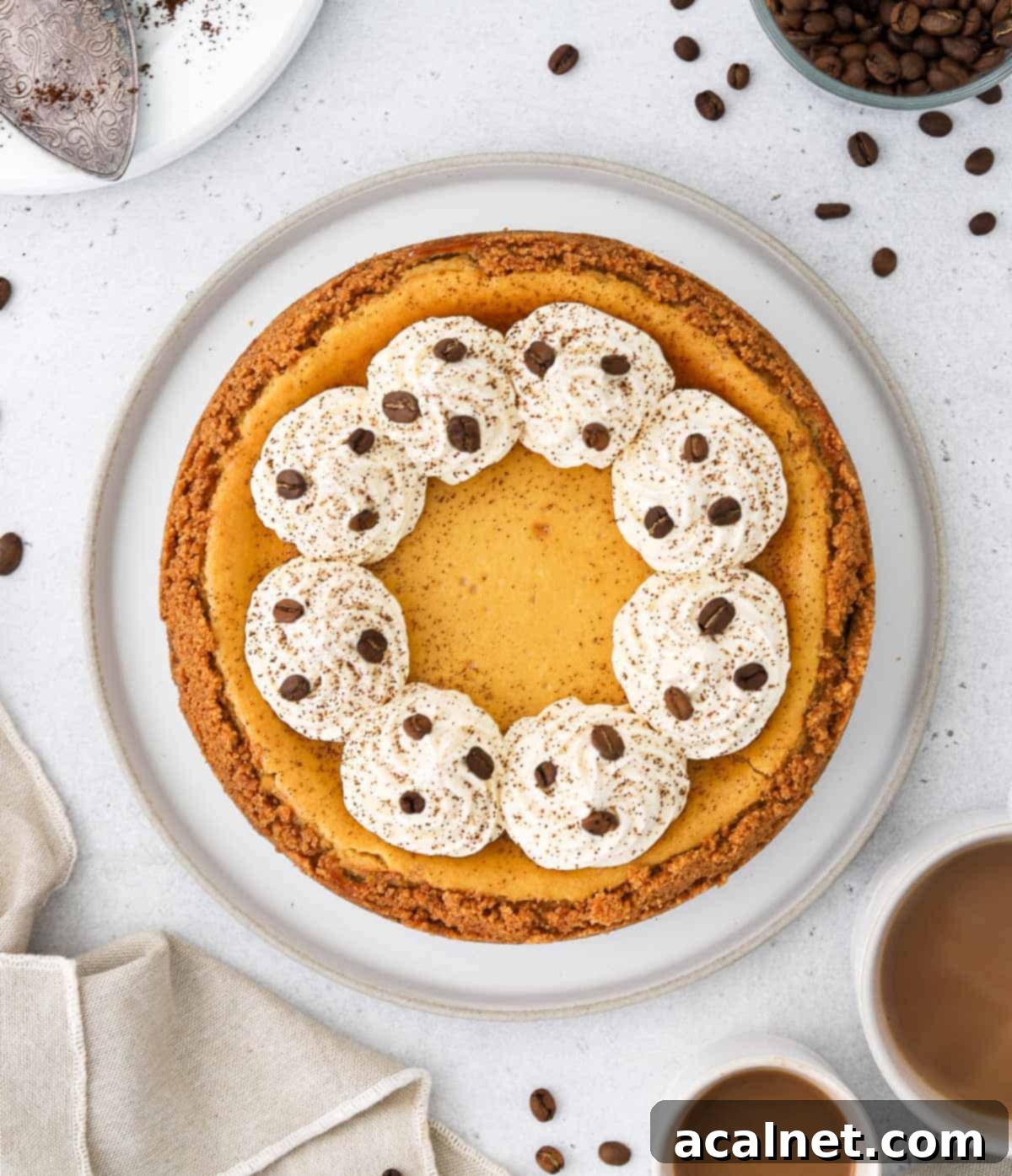
How to Bake a Perfect Coffee Cheesecake
Creating this incredible Coffee Cheesecake is a structured process, ensuring each component contributes to the final masterpiece. You’ll start with the crunchy cookie crust, move on to the silky coffee cheesecake batter, and finally, prepare the optional but highly recommended coffee-flavored whipped cream just before serving.
Crafting the Flawless Cookie Crust
- Prepare Your Pan: Begin by preparing a 22 cm / 9 inch springform pan. Line the bottom with a circle of baking paper. This is essential for easy removal of the cheesecake once it’s set.
- Photo 1: Crushing the Cookies: Take your Digestive Biscuits (or chosen cookies) and crush them into very fine crumbs. A food processor is the quickest and most efficient tool for this, ensuring a uniform texture. If you don’t have one, place the cookies in a large, sturdy freezer bag and use a rolling pin or the bottom of a heavy pan to crush them thoroughly until no large chunks remain. Remember, if using unsweetened graham crackers, consider adding 1-2 tablespoons of granulated sugar to the crumbs at this stage.
- Photo 2 & 3: Combining with Butter: Pour the melted Unsalted Butter over the fine cookie crumbs. Mix thoroughly until all the crumbs are evenly moistened and the mixture resembles wet sand. This ensures a cohesive crust that won’t fall apart.
- Photo 4: Forming the Crust: Transfer the buttery crumbs into your prepared springform pan. Use the bottom of a flat-bottomed cup or your clean fingers to firmly and evenly press the crumbs into the bottom and up the sides of the pan. The key here is to pack it down as tightly as possible, creating a solid, compact crust with no loose crumbs. This firm base is crucial for structural integrity.
- Chill Time: Place the prepared crust in the fridge while you get started on the cheesecake filling. Chilling helps the butter solidify, setting the crust and preventing it from becoming soggy during baking.
Pro Tip for the Crust: I prefer a cheesecake with beautifully high crust edges, which requires the full amount of cookies and butter listed. However, if you prefer a simpler crust that only covers the bottom of the pan, simply halve the quantities of cookies and butter.
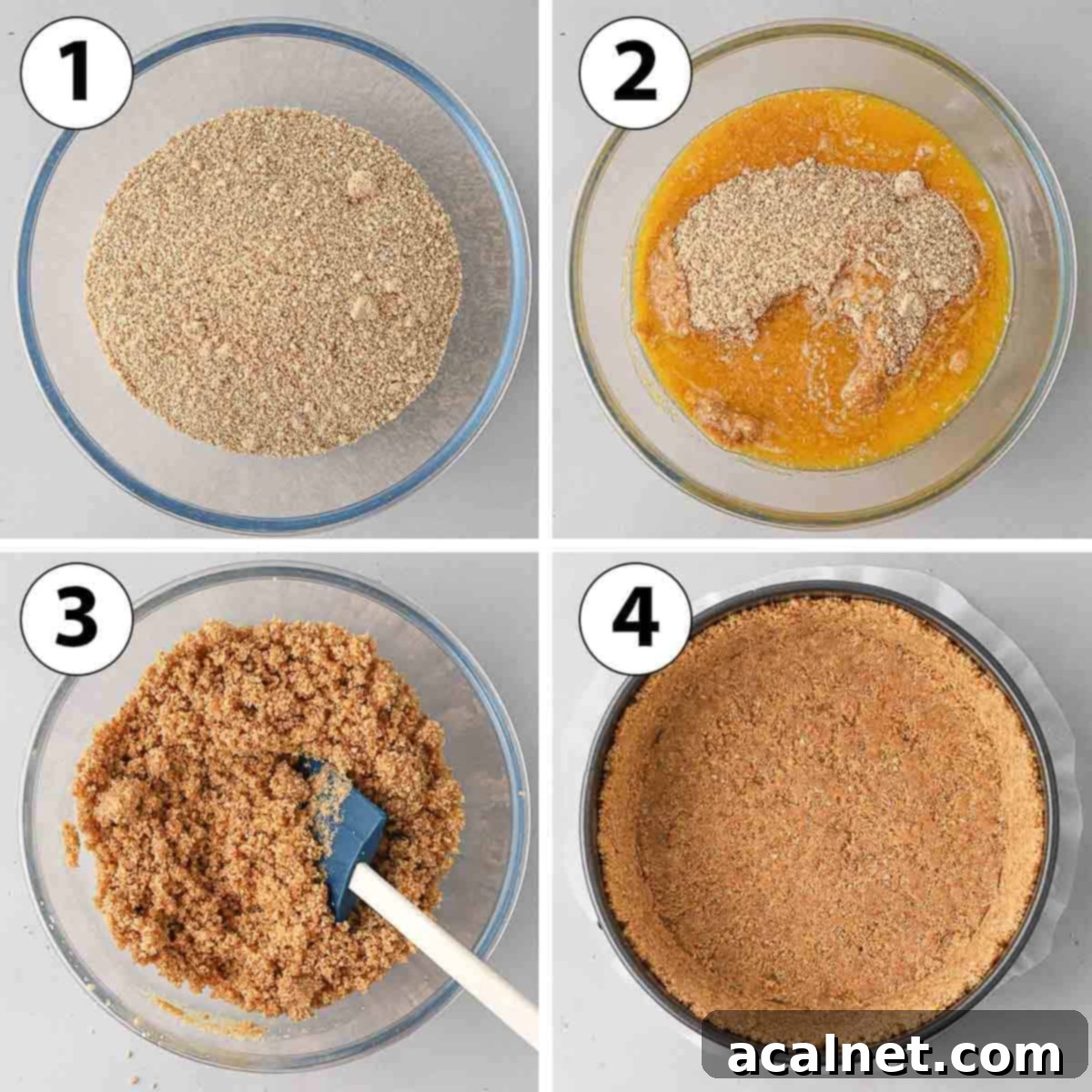
Preparing the Rich Coffee Cheesecake Filling
- Preheat Oven: Preheat your oven to a precise 150°C (300°F). Position an oven rack as low as possible in your oven. A lower temperature and rack are key for baking cheesecake evenly and preventing cracks without a water bath.
- Cool the Coffee: Brew your fresh espresso or coffee and set it aside to cool completely. Warm coffee can scramble the eggs or curdle the dairy, so patience here is a virtue.
- Photo 5: Creaming Dairy: In the bowl of your stand mixer (fitted with the paddle attachment) or a large mixing bowl (if using a hand mixer), combine the room temperature Cream Cheese and Sour Cream. Mix on medium speed until the mixture is completely smooth and free of any lumps. This step is critical; if your dairy isn’t at room temperature, it will be very difficult to get a smooth batter. Be careful not to overmix at this stage, as incorporating too much air can lead to cracks later.
- Photo 6: Adding Flavor & Sweetness: Now, add the Caster Sugar, cooled freshly brewed Coffee, Vanilla Paste, and the optional Coffee Extract. Mix on low speed until all ingredients are just combined. Stop the mixer occasionally to scrape down the sides and bottom of the bowl with a rubber spatula, ensuring everything is thoroughly incorporated without over-mixing.
- Photo 7: Gentle Egg Incorporation: This is perhaps the most crucial step for a crack-free cheesecake! Add the Eggs one at a time, mixing on the lowest speed possible, just until each egg is combined. Stop mixing as soon as you no longer see streaks of egg. Over-mixing the eggs is the primary culprit for cracks in baked cheesecakes. Excessive air introduced into the batter will cause the cheesecake to puff up too much in the oven, then collapse and crack as it cools.
- Photo 8: Bake to Perfection: Carefully pour the silky coffee cheesecake filling into your chilled cookie crust. Place the springform pan on the lowest oven rack. Bake for approximately 60 to 70 minutes. The cheesecake is ready when the edges are set, but the very center still has a slight, gentle jiggle when the pan is lightly nudged. Remember, no water bath is required for this recipe!
Troubleshooting Tip: If you notice your cheesecake browning too quickly or appearing to burn, your oven might be running hot. Consider lowering the temperature slightly or adjusting the baking time.
To cool down the cheesecake and master the art of preventing cracks:
- Slow Cooling Phase 1 (Oven): Once the baking time is complete, turn off your oven. Prop the oven door open slightly (a wooden spoon works perfectly to keep a gap) and leave the cheesecake inside for 1 full hour. This gradual temperature change is key to preventing a sudden shock that can cause cracks.
- Slow Cooling Phase 2 (Room Temperature): After an hour in the cooling oven, remove the cheesecake and let it continue to cool at room temperature for another hour.
- Slow Cooling Phase 3 (Fridge): Finally, transfer the cheesecake to the fridge for at least one hour, though preferably overnight. Chilling overnight is highly recommended as it allows the cheesecake to fully set and develop its ultimate creamy texture and rich flavor. Once fully cooled and set, carefully remove it from the springform pan.
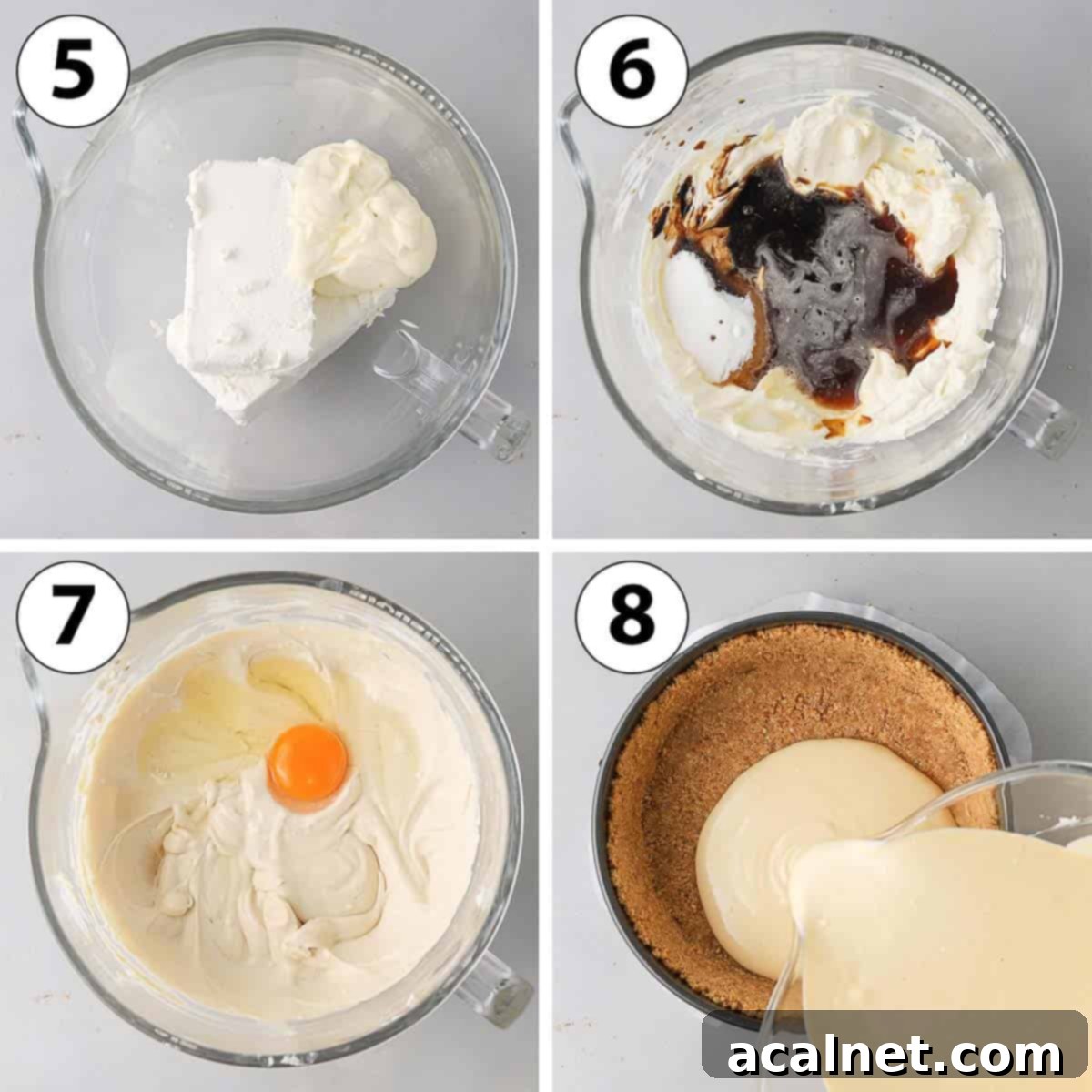
Creating the Velvety Coffee Whipped Cream
The Coffee Whipped Cream is the perfect grand finale for your cheesecake. While entirely optional, it adds a delightful airy texture and an extra boost of coffee flavor that complements the richness of the cheesecake beautifully. It can be prepared in advance and stored, but for the freshest and most appealing presentation, we recommend piping it over the cheesecake just before serving.
- Whip it Up: Ensure your Heavy / Thickened Cream is very cold. Pour it into the bowl of your mixer (or a large mixing bowl if using a hand mixer). Add the Caster Sugar and Coffee Extract (or your dissolved instant coffee/espresso mixture, if using).
- Achieve Stiff Peaks: Begin whisking on medium speed, gradually increasing to high speed, until the cream forms stiff peaks. Stiff peaks mean that when you lift the whisk, the cream holds its shape firmly. Be vigilant and careful not to overwhip the cream; if you go too far, it can become grainy and eventually turn into butter. Once you start seeing stiff peaks forming, continue whisking only for a few seconds at a time until you reach your desired consistency.
- Serve with Style: Transfer the whipped cream into a piping bag fitted with a star-shaped nozzle (or any decorative tip you prefer). Pipe elegant swirls or dollops over the chilled cheesecake. For an extra touch of sophistication, lightly dust with a sprinkle of espresso powder and garnish with a few whole coffee beans.

Coffee Cheesecake: Your Questions Answered
For the most robust and authentic coffee flavor, freshly brewed espresso is undoubtedly the best choice, especially if you have an espresso machine. Using quality, fresh coffee beans will impart a deep, aromatic, and truly delicious flavor to your cheesecake. If an espresso machine isn’t available, high-quality instant espresso powder or fine instant coffee granules dissolved in a small amount of hot water are excellent alternatives. You can adjust the strength of the coffee to match your preference – a stronger brew for a bolder coffee taste, or a slightly weaker one for a more subtle hint.
Absolutely! The beauty of cheesecake crusts is their versatility. While Digestive Biscuits offer a lovely neutral sweetness and crumbly texture, you can experiment with many other types of cookies. Oreos make for a fantastic chocolatey crust, Biscoff cookies add a spiced, caramelized note, and classic Graham Crackers provide a wholesome base. If you opt for unsweetened cookies like traditional graham crackers, we highly recommend adding 1 to 2 tablespoons of caster sugar or fine granulated sugar to the crushed crumbs to ensure your crust is perfectly balanced in sweetness.
One of the most appealing aspects of this particular coffee cheesecake recipe is that it successfully bypasses the need for a water bath! Many bakers find water baths cumbersome and sometimes messy. Our method focuses on achieving the ideal, smooth texture and preventing cracks through precise temperature control and a gradual cooling process. By baking the cheesecake on the lowest rack of your oven at a low temperature and allowing it to cool very slowly—first in the turned-off oven, then at room temperature, and finally in the fridge—you’ll achieve a beautifully smooth, uncracked surface and a wonderfully creamy interior. It’s a simpler approach that yields fantastic results!
Our recommended topping is the homemade Coffee Whipped Cream, which perfectly complements the espresso flavor of the cheesecake. However, feel free to customize your topping to your liking! A simple, unsweetened whipped cream would also be delicious, allowing the cheesecake’s coffee flavor to shine through. For a more decadent touch, consider a rich Chocolate Ganache drizzled over the top, or even a Whipped Ganache Frosting for an airy yet intense chocolate finish. A dusting of cacao powder can add a sophisticated bittersweet note. If you crave an even sweeter and more robust coffee flavor, a homemade Coffee Buttercream would be a truly indulgent choice.

Essential Tips for a Perfect Baked Coffee Cheesecake
Achieving a flawless, crack-free, and incredibly creamy baked cheesecake is easier than you think, especially when you keep these crucial tips in mind. Paying attention to these details will ensure your coffee cheesecake turns out perfectly every time:
- Room Temperature Ingredients are Non-Negotiable: This cannot be stressed enough! It is paramount that all your dairy ingredients, especially the Cream Cheese and Sour Cream, as well as the Eggs, are at room temperature. If the cream cheese is too cold, it will not blend smoothly with the other ingredients, resulting in a lumpy batter and a less desirable texture in the final cheesecake. Room temperature ingredients emulsify much better, creating a silky-smooth, uniform batter.
- Avoid Over-Mixing, Especially After Adding Eggs: This is the golden rule for preventing cracks in baked cheesecakes. The primary reason a cheesecake cracks or collapses is the incorporation of too much air into the batter, particularly when mixing in the eggs. This air expands rapidly in the hot oven, causing the cheesecake to rise excessively. As it cools, the air escapes, and the unsupported structure collapses, leading to unsightly cracks. Always mix on the lowest speed possible, and only until the ingredients are just combined. If necessary, finish mixing by hand with a spatula to gently incorporate any remaining streaks.
- Master the Slow Cooling Process to Prevent Cracks: A sudden change in temperature is a cheesecake’s worst enemy. To ensure a beautiful, unblemished surface, implement a progressive cooling method:
- Oven Cooling: Once baked, turn off your oven. Leave the cheesecake inside with the oven door propped open slightly (a wooden spoon works perfectly). Let it cool in this environment for 1 hour.
- Room Temperature Cooling: After the oven cool-down, remove the cheesecake and allow it to sit at room temperature for another hour.
- Refrigeration: Finally, transfer the cheesecake to the fridge. Chill it for at least one hour, or ideally, overnight. This extended chilling period not only prevents cracks but also allows the cheesecake to firm up completely and develop its optimal creamy texture and depth of flavor.
Storing & Freezing Your Coffee Cheesecake
Proper storage is key to maintaining the freshness and deliciousness of your baked coffee cheesecake. Planning ahead can also enhance its flavor and texture.
- Refrigeration: This baked cheesecake should always be stored in an airtight container in the fridge. It will stay fresh and delicious for up to 3 days. In fact, cheesecake often tastes even better the day after it’s made, as the flavors meld and the texture becomes incredibly creamy after spending a night chilling in the refrigerator.
- Coffee Whipped Cream: If you’re topping your espresso cheesecake with the coffee whipped cream, it’s best to add it just before serving for the freshest taste and best presentation. The whipped cream itself can be prepared in advance and stored in an airtight container in the fridge for up to 24 hours.
- Freezing: We generally do not recommend freezing this baked cheesecake. The delicate, creamy texture of baked cheesecakes can be compromised during the freezing and thawing process, potentially becoming crumbly or watery. For the best experience, enjoy it fresh and chilled!
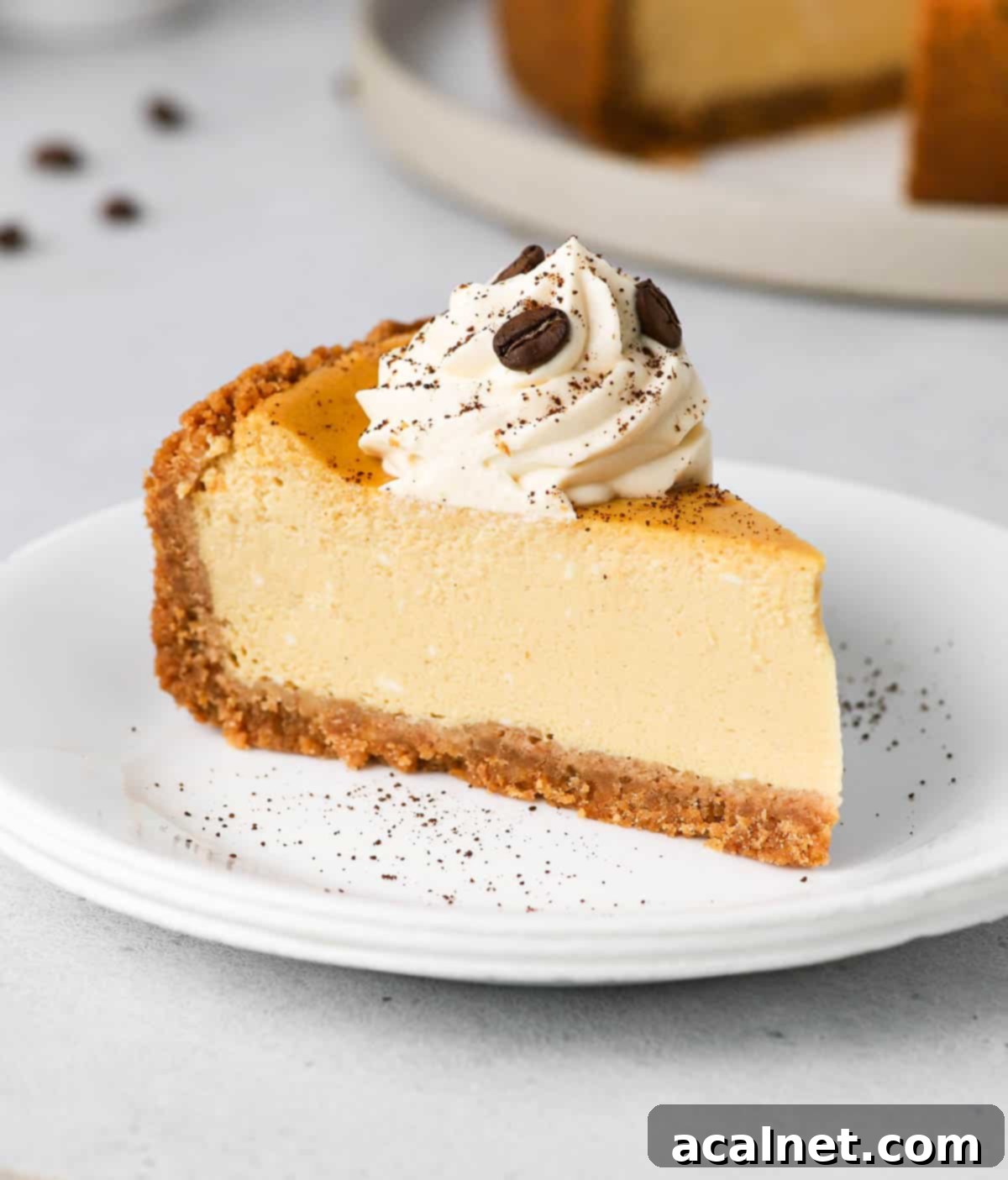
Explore More Irresistible Coffee Desserts
If this Coffee Cheesecake has ignited your passion for coffee-infused sweets, you’re in luck! Coffee is a versatile flavor that shines in many different dessert applications. Here are some other delightful coffee desserts to explore:
- Coffee Choux Buns: Light and airy pastry filled with coffee-flavored cream.
- Coffee Financiers: Elegant French almond cakes with a hint of coffee.
- Coffee Loaf Cake: A moist and flavorful cake, perfect for fika or an afternoon treat.
- Coffee Mousse Cups: Velvety smooth and intensely coffee-flavored mousse.
- Coffee Crème Brûlée: A classic dessert with a delightful coffee twist and a crisp caramel top.
- Coffee Panna Cotta: A simple yet sophisticated Italian dessert with a delicate coffee flavor.
Made this recipe?
Let us know if you liked it by leaving a comment below, and tag us on Instagram @a.baking.journey with a photo of your creation!
Recipe
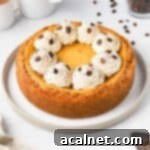
Baked Coffee Cheesecake
Servings:
12
Author:
Sylvie
30 minutes
0 days
1 hour
10 minutes
8 hours
0 days
9 hours
40 minutes
Print Recipe
Prevent your screen from going dark
Ingredients
Crust
- 300 gr (10 oz) Digestive Biscuits, crushed, (about 3 cups of crushed cookies)
- 150 gr (2/3 cup) Unsalted Butter, melted
Coffee Cheesecake Filling
- 120 ml (1/2 cup) Freshly brewed Espresso, or coffee
- 500 gr (18 oz) Cream Cheese, at room temperature
- 180 ml (3/4 cup) Sour Cream, at room temperature
- 120 gr (1/2 cup + 2 tablespoon) Caster Sugar, or fine white granulated sugar
- 1 teaspoon Vanilla Paste
- 1 teaspoon Coffee Extract, optional
- 3 Eggs, at room temperature
Coffee Whipped Cream
- 180 ml (3/4 cup) Heavy / Thickened Cream, or whipping cream
- 40 gr (3 tablespoon) Caster Sugar, or fine white granulated sugar
- 1/2 teaspoon Coffee Extract
Instructions
Crust
- Line the bottom of a 22 cm / 9 inch Springform Pan with Baking Paper.
- Crush the Digestive Biscuit (or your choice of cookies) into very fine crumbs. Add the Melted Butter and mix until the mixture resembles wet sand.
- Firmly press the crumbs to the bottom and sides of the Springform Pan to create the crust (see note 1). Place in the fridge while you prepare the cheesecake filling.300 gr (10 oz) Digestive Biscuits, crushed,
150 gr (2/3 cup) Unsalted Butter
Coffee Cheesecake Filling
- Preheat your oven on 150’C/300’F and prepare a rack on the lowest part of the oven.
- Prepare the Espresso / Coffee and set aside to cool down.120 ml (1/2 cup) Freshly brewed Espresso
- Place the Cream Cheese and Sour Cream in the bowl of your mixer (or a large mixing bowl if using a hand mixer). Mix with the paddle attachment on medium speed until smooth (see note 2).500 gr (18 oz) Cream Cheese,
180 ml (3/4 cup) Sour Cream - Add the Sugar, freshly brewed Coffee, Vanilla Paste and Coffee Extract (optional) and mix until combined. Stop to scrap the edge/bottom of the bowl if required.120 gr (1/2 cup + 2 tablespoon) Caster Sugar,
1 teaspoon Vanilla Paste,
1 teaspoon Coffee Extract - Add the Eggs one by one, mixing on low speed (see note 3). Stop as soon as combined.3 Eggs
- Pour the coffee cheesecake filling into the crust, then place in the oven (on the lowest rack) to bake for 60 to 70 minutes. The filling should still jiggle very slightly (see note 4).
- Turn off the oven, open the door slightly (use a wooden spoon to hold the door open) and leave the cheesecake to cool down inside the oven for 1 hour. Take out of the oven and leave to cool down at room temperature for 1 other hour, then in the fridge for at least one hour, or preferrably overnight. Remove from the springform pan once fully cooled.
Coffee Whipped Cream
- Place the very cold Cream, Sugar and Coffee Extract (see note 5 if you don’t have coffee extract) in the bowl of your mixer (or large mixing bowl if using a hand mixer) and whisk on medium to high speed until you reach stiff peaks (see note 6).
- Pipe over the cool Cheesecake just before serving. Optionally, dust with a litle bit of espresso powder and top with a few coffee beans.180 ml (3/4 cup) Heavy / Thickened Cream,
40 gr (3 tablespoon) Caster Sugar,
1/2 teaspoon Coffee Extract
Would you like to save this recipe?
We’ll email this post to you, so you can come back to it later!
Notes
Ingredient Notes:
- Digestive Biscuits: If Digestive Biscuits are not available, feel free to substitute with any type of cookie you prefer, such as Biscoff, Oreos, or vanilla wafers. If using Graham Crackers, consider adding 1-2 tablespoons of sugar to the crushed crumbs as they are often less sweet.
- Freshly Brewed Espresso: This recipe calls for 120 ml (1/2 cup) of freshly brewed espresso, which is roughly equivalent to 3 shots. If using instant coffee or espresso powder, dissolve about 3 to 4 teaspoons of your chosen powder in 120 ml / 1/2 cup of boiling water. Adjust the amount of coffee powder to make it weaker or stronger, according to your taste preference. Remember to let it cool completely before adding to the batter.
Instruction Notes:
- To create a firm crust, use the back of a cup or a spoon to press the crumbs down very firmly into the pan. There should be no loose crumbs. This recipe creates a crust with quite high sides; if you prefer a crust that only covers the bottom, you can divide the crust ingredients by two.
- For a smooth, lump-free filling, it’s crucial that both the Cream Cheese and Sour Cream are at room temperature. Cold dairy will result in a lumpy batter. Mix only until just smooth to avoid incorporating too much air.
- When adding eggs, mix on the lowest speed possible and stop as soon as each egg is just combined. Over-mixing eggs introduces excess air, which can cause the cheesecake to rise rapidly and then crack as it cools. If needed, finish incorporating by hand with a spatula.
- If the cheesecake begins to brown too quickly while baking, it often indicates that your oven temperature is too high. You might need to adjust your oven’s temperature or cover the top loosely with foil.
- If coffee extract is not available for the whipped cream, you can dissolve 1 teaspoon of instant coffee or espresso powder in a tablespoon of warm cream. Chill this coffee-infused cream thoroughly in the fridge until very cold before adding it to the rest of the heavy cream and sugar for whipping.
- When making the whipped cream, be careful not to overwhip. Overwhipped cream will become grainy and can separate. Whisk on medium-high speed until stiff peaks form; then, continue whisking only for a few seconds at a time to reach the perfect consistency.
Nutrition (per serving)
Calories:
488
kcal
|
Carbohydrates:
36
g
|
Protein:
6
g
|
Fat:
37
g
|
Saturated Fat:
20
g
|
Polyunsaturated Fat:
2
g
|
Monounsaturated Fat:
10
g
|
Trans Fat:
1
g
|
Cholesterol:
142
mg
|
Sodium:
289
mg
|
Potassium:
154
mg
|
Fiber:
1
g
|
Sugar:
23
g
|
Vitamin A:
1246
IU
|
Vitamin C:
1
mg
|
Calcium:
83
mg
|
Iron:
1
mg
